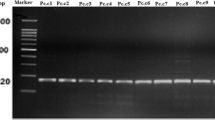Abstract
‘Lemon Myrtle’ is becoming increasingly popular in Europe both for use in cuisine and phytotherapy. However, this common name covers two completely different species, Backhousia citriodora F. Muell. and Leptospermum citratum Challinor, Cheel & A.R.Penfold. These species differ with respect to secondary compounds and even can cause, if mixed up and applied in high dose, toxic effects. We describe how the two species can be discriminated microscopically making use of differences in the morphology of leaf pavement cells and the relative size of palisade parenchyma. Based on the large subunit of ribulose-1,5-bisphosphate carboxylase oxygenase (rbcL) as molecular marker, the phylogenetic position of the two species within the Myrtaceae could be clarified. This sequence information was used to develop a simple assay to discriminate the two species even in dried and highly fragmented mixtures as typically occurring in commercial samples. This assay utilises the occurrence of single-nucleotide exchanges between those species that produce different fragments when the rbcL amplificates are restricted with Sac II.





Similar content being viewed by others
References
Ernst E (1998) Harmless herbs? A review of the recent literature. Am J Med 104:170–178
European Parliament and European Council (1997) Regulation on novel foods and novel food ingredients no. 258/97 of 27 January 1997. J Eur Comm L 43:1–5
Green JM, Draper AK, Dowler EA (2003) Short cuts to safety: risk and `rules of thumb’ in accounts of food choice. Health Risk Soc 5:33–52
Hahn H, Michaelson I (1996) Mikroskopische Diagnostik pflanzlicher Nahrungs-, Genuss- und Futtermittel, einschliesslich Gewürze. Springer, Berlin
von Mueller FJH (1859) Fragmenta Phytographiae Australiae 1:78
Thompson J (1989) A revision of the genus Leptospermum (Myrtaceae). Telopea 3:301–448
Atkinson W, Brice H (1955) Antibacterial substances produced by flowering plants. Aust J Exp Biol 33:547–554
Greive KA, Staton JA, Miller PF, Peters BA, Oppenheim VMJ (2010) Development of Melaleuca oils as effective natural-based personal insect repellents. Aust J Entomol 49:40–48
Burke BE, Baillie JE, Olson RD (2004) Essential oil of Australian lemon myrtle (Backhousia citriodora) in the treatment of molluscum contagiosum in children. Biomed Pharmacother 58:245–247
Hood JR, Burton DM, Wilkinson JM, Cavanagh HMA (2010) The effect of Leptospermum petersonii essential oil on Candida albicans and Aspergillus fumigatus. Med Mycol 48:922–931
Lazar-Baker E, Hetherington S, Ku V, Newman S (2011) Evaluation of commercial essential oil samples on the growth of postharvest pathogen Monilinia fructicola (G. Winter) Honey. Lett Appl Microbiol 52:227–232
Doran JC, Brophy JJ, Lassak EV, House APN (2001) Backhousia citriodora F. Muell. Rediscovery and chemical characterization of the L-citronellal form and aspects of its breeding system. Flavour Fragr J 16:325–328
Hayes AJ, Markovic B (2002) Toxicity of Australian essential oil Backhousia citriodora (Lemon myrtle). Part 1. Antimicrobial activity and in vitro cytotoxicity. Food Chem Toxicol 40:535–543
Hayes AJ, Markovic B (2003) Toxicity of Australian essential oil Backhousia citriodora (Lemon myrtle). Part 2. Absorption and histopathology following application to human skin. Food Chem Toxicol 41:1409–1416
Consortium for the Barcode of Life (2009) A DNA barcode for land plants. Proc Natl Acad Sci USA 106:12794–12797
Walsh NG, Entwisle TJ (1996) Flora of Victoria, vol 3. Inkata Press, Melbourne
Doyle JJ, Doyle JL (1987) A rapid DNA isolation procedure from small quantities of fresh leaf tissues. Phytochem Bull 19:11–15
Tamura K, Dudley J, Nei M, Kumar S (2007) MEGA4: molecular evolutionary genetics analysis (MEGA) software version 4.0. Mol Biol Evol 24:1596–1599
Saitou N, Nei M (1987) The neighbor-joining method: a new method for reconstructing phylogenetic trees. Mol Biol Evol 4:406–425
Felsenstein J (1985) Confidence limits on phylogenies: an approach using the bootstrap. Evolution 39:783–791
O’Brien TP, Feder N, McCully ME (1964) Polychromatic staining of plant cell walls by Toluidine Blue O. Protoplasma 59:367–373
Acknowledgments
We acknowledge Angelika Piernitzki and Joachim Daumann, Botanical Garden of the University, for excellent horticultural support during the project and Olivia Huber for skillful technical support during DNA extraction and analysis.
Conflict of interest
The authors declare that they do not have any conflict of interest.
Author information
Authors and Affiliations
Corresponding author
Rights and permissions
About this article
Cite this article
Horn, T., Barth, A., Rühle, M. et al. Molecular diagnostics of Lemon Myrtle (Backhousia citriodora versus Leptospermum citratum). Eur Food Res Technol 234, 853–861 (2012). https://doi.org/10.1007/s00217-012-1688-9
Received:
Revised:
Accepted:
Published:
Issue Date:
DOI: https://doi.org/10.1007/s00217-012-1688-9




